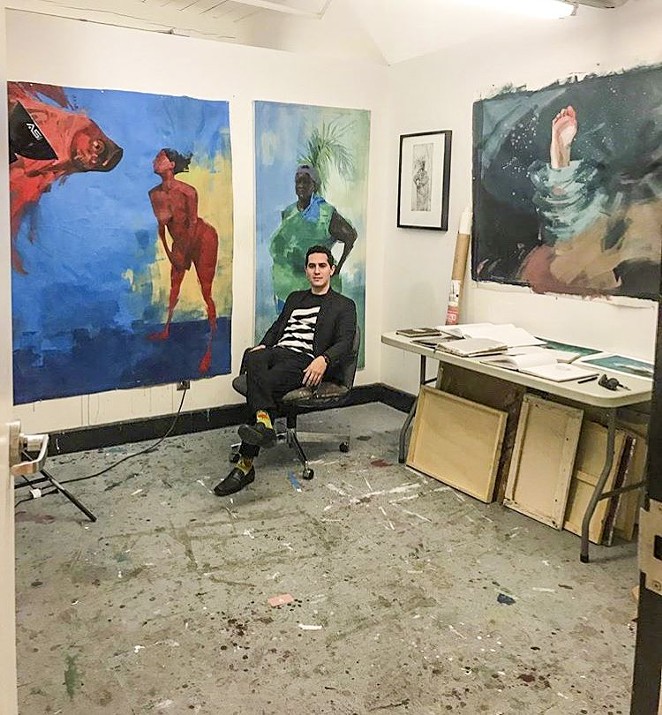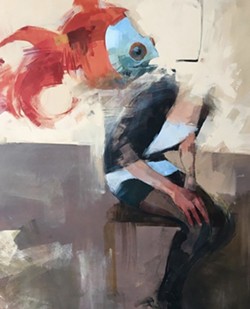FOR painter Pedro Covo, all his work begins in the sketchbook.
Originally from Cartagena, on the Caribbean coast of Colombia, Covo traveled the world with an illustration job before coming to SCAD to pursue his love of painting.
Through his travels, Covo always stays true to his origin, creating work that is Colombian and Caribbean in nature.
We spoke with Covo last week.
1. How did you come to be in Savannah?
I worked for ten years as an illustrator before coming to SCAD. I graduated from my undergrad in 2011 and worked for a French-Canadian agency. They had me travel a lot. The work was pretty good, but I was still doing editorial mostly, and it wasn’t what I was expecting from the illustration world. I was more happy doing my paintings during the weekends, but I couldn’t fully commit to it, so I quit in 2017 and tried to make a life as a painter, which is a very big step into the abyss.
I always wanted to be a painter, but I was afraid of the uncertainty of the job, so I decided to apply to a few schools. I was living basically all over before coming here. Every six months I was moving somewhere else. It was great—that’s the best part of the job. It is emotionally exhausting because you have to meet new people every place you go.
2. What was the transition like from illustrating to painting?
The medium was kind of the same. I was working with acrylics and oils, but a lot of digital work too. Right now, it’s a little bit the opposite. Sometimes I do a digital sketch really quick, then go and paint. [At my previous job] I did acrylic and then moved into digital and finished in digital. It’s kind of the same process, but backwards.
Everything starts in the sketchbook for me. It’s more or less the same process. The main difference is that I’m not illustrating anyone else’s story but my story. It’s a double-edged sword. It’s easier to do someone else’s story. To figure out what makes your story yours and what it is that you can tell is a little bit of work itself. It’s a lot of writing and a lot of reading to get there.
It’s what I wanted to do. I turned 30 and thought to myself, “I don’t have any kids or anything, so if I don’t try to do this right now, I don’t think I will have a moment later in life where I can pursue this.
3. How has traveling informed your artistic practice?
I think traveling for me worked to put in perspective where I come from. When getting to know a new place, you know more what the things you take for granted, and you realize things are different and what makes the place where you are from, the culture you come from, different from everything else.
That’s my work. Wherever I am, it doesn’t matter if I’m here or anywhere, I’m painting a Colombian painting, or a Caribbean painting. Of course, traveling helps you figure out what it is that makes a Caribbean painting a Caribbean painting. I don’t know if I’m successful or not but that’s what I’m aiming for [laughs].
4. Let’s talk about your work and how it’s evolved.
I was working on swimmers for maybe two, three years. This was just the mundane life in the Caribbean. Everything is around the ocean. So I started doing the paintings and it became a very serious business at the end. I spent almost four years painting people swimming before I arrived at SCAD. I tried to move on to something else.
The portraits [I do now] are me trying to figure out what to do at SCAD that was different from what I was doing before. I cannot just sit down and think and come up with something. I have to work and work and figure out where I’m going along the way.
It’s been one year since I started doing portraits in my sketchbook. I can spend three months without painting a canvas, but I have to paint or draw in my sketchbook. I was just drawing and realized that I was just drawing my friends here, the people I spend time with here in Savannah. Honestly, my life here in Savannah is all day in my studio and maybe at night I’ll go to a bar and have a drink with the same people. I try to sit down with people and spend a few hours with them and make a live painting out of this interaction.
Most recently, I’ve been doing more mundane situations and trying to get a grasp on these quotidian life situations that you take for granted sometimes. I come from an illustration background, so I like to tell stories somehow. I’m just trying to be honest with who I am and where I come from, and trying to produce honest work based on my life.
5. What’s next for you?
I graduate by the end of the year. I am not looking forward to it. I would be in school forever if I could. I love being in school, the environment of people with the same interest. I think I get more out of my peers than I get from anything else. I try to steal everything I like from everybody here. It’s a lot of people working and it’s a great energy.
After being here, I definitely want to pursue a teaching situation because it’s just a way to get involved in that environment again. I feel like with the current political situation here in the U.S., I would prefer to move on, but I would not discard the possibility of staying here if I got a good job offer. As much as I love Savannah, I want to always remember this city with the feeling of my time here as a student. I don’t want to burn it out. Usually when I talk to people who have lived here for a long time, I listen to a lot of complaints. I really enjoy this town.



